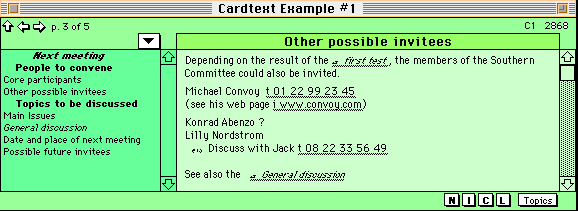
Cardtext is a freeware, for Apple Macintosh™, on which I am currently working.
I don't know yet when a first version will be available for dissemination, although I have personally been using preliminary versions of it for more than 2 years !
Cardtext is based on Hypercard™.
You will find here
The objectives of Cardtext
Cardtext is focused on helping people who want to store short personal notes or textual information, change it frequently, and create and modify easily hypertext links among this information, in a very flexible way.
Cardtext is presently like a "project", under development. The main orientations of this project are described below.
Main concepts of Cardtext
In its present draft form, Cardtext uses the following main "objects":
Here is a simplified picture of a Cardtext stack, showing these concepts :

This card shows two main fields. The left one (called "topics") stores names of cards or other objects and is shared by all cards; clicking on a line (other than a bold one) leads to the corresponding object. The right one (called merely "A", and starting here with "Depending..") is different on each card and includes text or notes you want to keep; you can modify it at any time. Above fld "A", the fld "Title" includes a title for field "A" (here: "Other possible invitees").
At the top right of the card appears the id of the stack (here "C1"), and the id of the card. The three buttons at the topleft of the card go to the last visited card, to the preceding and to the next card.
Field "A" includes, in this example, 4 types of hyperlinks: grouped text such as "first test" or "General discussion" let you jump to the place, on another card, where the corresponding subject appears; grouped text starting with an "i" indicates an Internet address, and, if clicked, will launch the chosen Web browser; grouped text starting with a "t" indicates a telephone number and, if clicked (or command clicked if the field is not locked) will dial the number; and the small characters preceding "Discuss with Jack" are a "target", which can be reached from other cards.
In field "Topics", the bold lines are "categories", allowing to group the lines at several hierarchical levels (Here "Next meeting" is the highest category, including the two sub-categories "People to convene" and "Topics to be discussed"). An object can appear several times in field "Topics": here, this card "3 of 5" appears twice, once with the content of the field "title" ("Other possible invitees"), and a second time with the name "Possible future invitees". Clicking on any of these two lines will lead you, from where you are (any card), to card 3 of 5. The line mentioned in italics ("General discussion") corresponds to an object which is not a card, but a place in a card. ("Discuss with Jack" could appear in this way in field Topics, but the user has chosen not to make it appear: one has the choice).
The PopUp button above field Topics allows to reorganize field topics: creating new categories, moving categories or individual lines, deleting lines, etc.
At the bottom right of the card, the buttons have the following functions: "N" creates a new card and prompts the user to propose a title, which is added to field Topics as a new line; "I" allows adding to field Topics more lines for the same card; "C" creates a target in fld "A"; "L" creates a hyperlink , in field "A", to an existing target elsewhere in the stack. The button "Topics" allows searches in field Topics (this is useful when field Topics includes several hundred lines!).
I am currently working on "folding and unfolding" categories in field "topics", and simultaneously on a different overall structure of fld "topics".
I would also like to introduce in Cardtext another object: the paragraph, and to allow any combination of paragraphs to appear, in a user defined field (a bit like the defunct software Lotus Agenda™, for those who have used it).
I believe that one of the main strengths of Cardtext is to allow flexible links, that you can move, copy and paste wherever you want, because they are just plain text.
Cardtext is designed for people who work on information and/or ideas: they want to be able to re-organize their stuff at any time, and to relate their ideas together.
Important note: to use these files, you need to have on your Mac, either Hypercard, or the Hypercard Player.
You can download the free HyperCard 2.4.1 Player from Apple (1.7 MB).
- Contribution to the "10th anniversary stack"
This "one card" stack is a revised version of my contribution to the "Hypercard 10th Anniversary stack"; it will show you some possibilities of Hypercard, and includes tricks that you can use.
Download PhLestang's10thAnn.Cont.sea.hqx (112 K)
- The complete 10th Anniversary stack (more than 2 MB) can be downloaded at Hypercard heaven